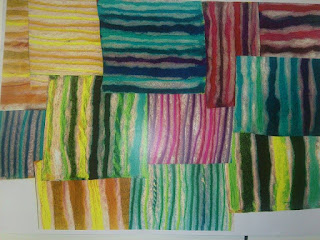This week has been slow with practical work due to writing
my dissertation. I have found doing research into textiles and wellbeing really
interesting and came across a very interesting theory of colour called
chromophobia. This has inspired my practical work because I am very aware of my
bold colour use and how it could be seen as “too eclectic” or perhaps
unprofessional, but chromophobia is the idea that Western society has made
colour seem “foreign” or “childish” or “unprofessional”. Reading about this
social phenomenon helps me feel more confident in taking risks and challenging
these concepts of colour.
I have also found that doing my essay on wellbeing has been quite relevent to my self-initiated brief because of the gratification I have got from helping someone see a whole new colour. ot only has it contributed to my wellbeing, doing a project to help someone else, I also feel like it's may have helped improve his wellbeing taking time out to consider how he sees colour.
Finally it all seems relevant to my new live brief based on the Gawthorpe Hall Archives, which is full of amazing intricate hand embroidery done by people who will have used embroidery for the same wellbeing purposes we use it for today.











































.JPG)

.jpg)



